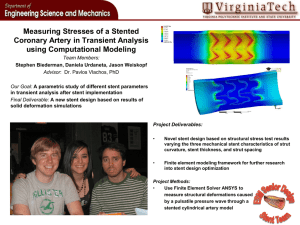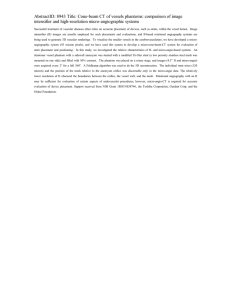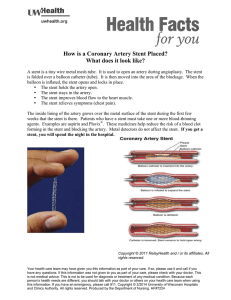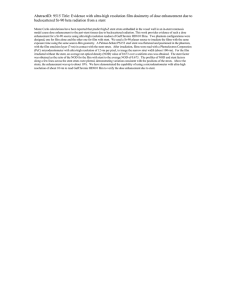INLAY OPTIMA® Ureteral Stent
advertisement
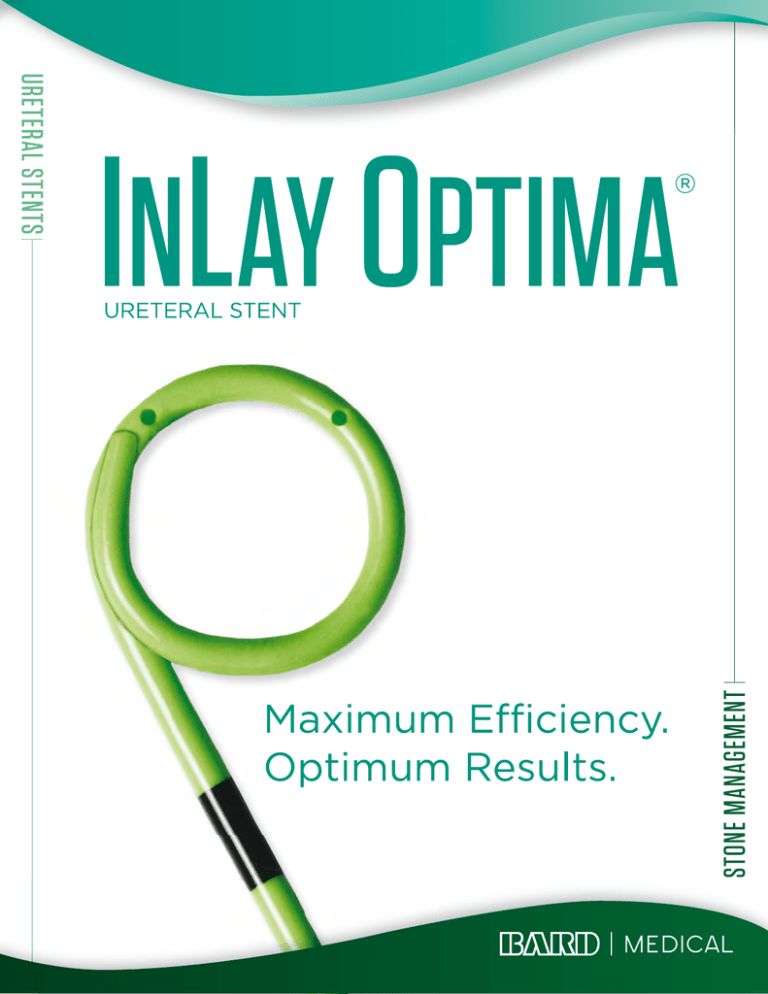
The trusted performance of the InLay® brand…optimized Take advantage of the exceptional performance characteristics of our solution to ureteral stenting challenges: the InLay Optima® ureteral stent. This next-generation stent offers all the recognized benefits of the Bard® InLay® ureteral stent: smooth, atraumatic insertion and patient comfort, indwelling for up to 365 days, plus its ability to help reduce the accumulation of urine calcium salts on the stent surface.1* 1 Choong SKS, Wood S, Whitfield HN. “A model to quantify encrustation on ureteric stents, urethral catheters, and polymers intended for urologic use.” BJU International (2000), 86. 414-421. Designed specifically for ease of insertion and navigation Gradual taper at tip of stent promotes smooth insertion and atraumatic navigation around obstructions. Pusher with fluoro marker helps achieve accurate placement, and distinctive lime green stent color enhances visibility. A quantitative comparison of ureteral stents showed InLay Optima® stent to be comparable to the InLay® stent in ease of insertion, and 32% easier to place than a leading competitive stent.* Now with an exceptional degree of smoothness Measured in microns A proprietary polymer blend results in a stent that is both biocompatible and ultra-smooth for patient comfort. 2.00 1.50 1.00 0.50 0.00 -0.50 InLay Optima® STENT -1.00 Smooth surface helps lower potential for urine calcium salt adhesion. -1.50 -2.00 COMPETITIVE STENT A Stent surface roughness is shown to be approximately 66% greater than that of InLay Optima stent. COMPETITIVE STENT B Stent surface roughness is shown to be approximately 79% greater than that of InLay Optima stent. Engineered to achieve optimal patient comfort % INCREASE IN SOFTNESS Because of less mechanical trauma at stent-tissue interface, a smoother stent surface may reduce ureteral reactions such as ulceration, epithelial hyperplasia, inflammation and edema.* Depending on stent size, stent softens from 29% up to 49% at body temperature to promote greater patient comfort.* Uniquely formulated “pHreeCOAT” coating stabilizes pH level on stent surface, helping to minimize adhesion of urine calcium salts, which may cause obstruction and impeded urine flow.* TEMPERATURE (°F) An innovative solution to the problem of urine calcium salt accumulation In vitro laboratory testing demonstrated the superior resistance to urine calcium salt accumulation of InLay Optima® stent vs. two leading competitive stents:* LEVELS OF ACCUMULATION 3.5 3.0 • Competitive stent A encrusted 34% more than InLay Optima® stent 2.5 2.0 • Competitive stent B encrusted 80% more than InLay Optima® stent 1.5 1.0 0.5 0.0 *Bench data on file, C. R. Bard, Inc. May not correlate to clinical performace. Bard® Stent A Stent B Ordering Information Size 4.7 Fr./14cm 4.7 Fr./20cm 4.7 Fr./22cm 4.7 Fr./24cm 4.7 Fr./26cm 4.7 Fr./28cm 4.7 Fr./30cm 6 Fr./14cm 6 Fr./20cm 6 Fr./22cm 6 Fr./24cm 6 Fr./26cm 6 Fr./28cm 6 Fr./30cm 7 Fr./14cm 7 Fr./20cm 7 Fr./22cm 7 Fr./24cm 7 Fr./26cm 7 Fr./28cm 7 Fr./30cm 8 Fr./14cm 8 Fr./20cm 8 Fr./22cm 8 Fr./24cm 8 Fr./26cm 8 Fr./28cm 8 Fr./30cm Without Guidewire Hydroglide® Guidewire Nitinol Guidewire 788414 788420 788422 788424 788426 788428 788430 788614 788620 788622 788624 788626 788628 788630 788714 788720 788722 788724 788726 788728 788730 788814 788820 788822 788824 788826 788828 788830 787414 787420 787422 787424 787426 787428 787430 787614 787620 787622 787624 787626 787628 787630 787714 787720 787722 787724 787726 787728 787730 787814 787820 787822 787824 787826 787828 787830 786414 786420 786422 786424 786426 786428 786430 786614 786620 786622 786624 786626 786628 786630 786714 786720 786722 786724 786726 786728 786730 786814 786820 786822 786824 786826 786828 786830 Multilength Ureteral Stent Without Guidewire Hydroglide® Guidewire Nitinol Guidewire 4.7 Fr./22-32cm 6 Fr./22-32cm 7 Fr./22-32cm 8 Fr./22-32cm 788400 788600 788700 788800 787400 787600 787700 786400 786600 786700 786800 For additional information contact your local Bard representative or call 1.800.526.4455. C. R. Bard, Inc. 800.526.4455 Indications for Use: The InLay Optima® Ureteral Stent and Multi-Length Ureteral Stent with Suture are indicated to relieve obstruction in a variety of benign, malignant and post-traumatic conditions in the ureter. These conditions include stones and/or stone fragments, or other ureteral obstructions such as those associated with ureteral stricture, malignancy of abdominal organs, retroperitoneal fibrosis or ureteral trauma, or in association with Extracorporeal Shock Wave Lithotripsy (ESWL). The stent may be placed using endoscopic surgical techniques or percutaneously using standard radiographic technique. It is recommended that the indwelling time not exceed 365 days. The stent is not intended as a permanent indwelling device. Contraindications: (Refer to the Instructions for Use for the Complete List of Adverse Effects, Precautions, and Warnings.) There are no known contraindications for use. Precautions: (Before use, consult product labels and inserts for any indications, contraindications, hazards, warnings, cautions and instructions for use.) • Suture may be cut off prior to stent placement. Remove suture if indwelling time is expected to be longer than 14 days. • Avoid improper handling of stent such as bending, kinking, tearing, etc. Misuse could damage the overall integrity of the stent. • Ureteral stents should be checked periodically for signs of encrustation and proper function. Periodic checks of the stent by cystoscopic and/or radiographic procedures are recommended at intervals deemed to be appropriate by the physician in consideration of the individual patient’s condition and other patient specific factors. When longterm use is indicted, it is recommended that indwelling time not exceed 365 days. The stent is not intended as a permanent indwelling device. • With any ureteral stent, migration is a possible complication, which could require medical intervention for removal. Selection of too short a stent may result in migration. • Care should be exercised when removing the stent from the inner polybag to eliminate tearing or fragmentation. • The insertion of a ureteral stent should only be done by those individuals who have comprehensive training in the techniques and risks of the procedure. Potential Complications: Potential complications associated with retrograde/antegrade positioning of indwelling ureteral stents include the following: • Edema • Stone formation • Peritonitis • Extravasation • Ureteral reflux •Stent dislodgement, fragmentation, migration, occlusion • Fistula formation • Loss of renal function • Hemorrhage •Pain/Discomfort • Stent encrustation • Hydronephrosis • Perforation of kidney, renal pelvis, ureter, and/or bladder • Ureteral erosion • Infection • Urinary symptoms Warning: After use this product may be a potential biohazard. Handle and dispose of in accordance with acceptable medical practice and with applicable local, state and federal laws and regulations. For the latest information, always check the “Instructions for Use” that comes packaged with the product. Please consult product labels and inserts for any indications, contraindications, hazards, warnings, cautions and directions for use. Covington, GA 30014 www.bardmedical.com Bard, InLay, InLay Optima and HydroGlide are trademarks and/or registered trademarks of C. R. Bard, Inc.©2015 C. R. Bard, Inc. All Rights Reserved. Printed in U.S.A. 1508-04 R11/15 BMD/URST/1115/0003

